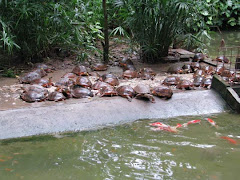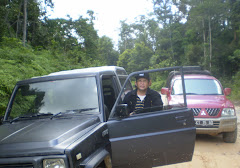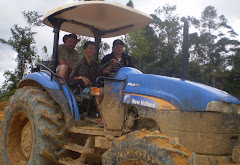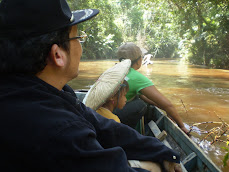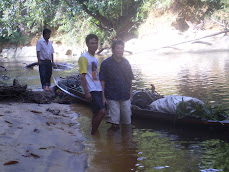<b>Daftar Nama Jenis Kura-kura yang dilindungi Undang-undang
No. Nama daerah
(local name) Familia Nama Inggris
(English name) Spesies
1. Tuntong Emydidae River terrapin Batagur baska
2. Biyuku Emydidae Aquatic tortoise Orlitia borneensis
3. Labi-labi moncong babi Carettochelydidae Irian tortoise Carettochelys insculpta
4. Kura-kura Irian leher pendek Chelidae New Guinea Snapper Elseya novaeguinea
5. Kura-kura Irian leher panjang Chelidae Long necked tortoisa Chelodina novaeguineae
6. Labi-labi Besar Triochydae Giant fresh water turtle Chitra indica
7. Penyu Ridel Cheloniidae Grey olive longerhead Lepidochelys olivaceae
8. Penyu Tempayan Cheloniidae Red brown longerhead Caretta caretta
9. Penyu Belimbing Dermochelyidae Leather back turtle Dermochelys coriacea
Senin, 28 September 2009
Senin, 14 September 2009
CUORA AMBONENSIS TERANCAM
Perdagangan Ilegal Ancam Kura Batok
Rabu, 25 Februari 2009 | 10:50 WIB
TEMPO Interaktif, Kuala Lumpur :Kelompok pemantau lingkungan Traffic menyatakan kura-kura batok (Cuora amboinensis) mulai langka di sejumlah daerah di Indonesia
Traffic mengatakan perdagangan illegal besar-besaran itu menyebabkan kura-kura itu menghilang dari kawasan yang semula banyak dihuni reptil tersebut. Mereka memperkirakan 2,1 juta kura-kura diperdagangkan setiap tahun. "Daging kura-kura itu digunakan dalam makanan maupun obat tradisional Cina, dengan pasar terbesar di Hong Kong, Cina, Singapura, danMalaysia Indonesia
Traffic mendesak pemerintahIndonesia
"Tingkat eksploitasi ilegal yang saat ini terjadi akan membuat kura-kura batok di seluruhIndonesia
Studi itu menemukan bahwa sedikitnya 18 pedagang binatang di Jawa, Sulawesi, Sumatera, danKalimantan
TJANDRA DEWI | AFP memperdagangkan satwa itu secara ilegal. Setiap pedagang menjual sekitar 2.230 ekor kura-kura tiap pekan sehingga total kura-kura yang diperdagangkan mencapai 2,1 juta ekor per tahun. Kura-kura batok telah terdaftar dalam konvensi CITES yang mengatur perdagangan binatang dan tumbuhan liar internasional.
Traffic mengatakan perdagangan illegal besar-besaran itu menyebabkan kura-kura itu menghilang dari kawasan yang semula banyak dihuni reptil tersebut. Mereka memperkirakan 2,1 juta kura-kura diperdagangkan setiap tahun. "Daging kura-kura itu digunakan dalam makanan maupun obat tradisional Cina, dengan pasar terbesar di Hong Kong, Cina, Singapura, dan
Traffic mendesak pemerintah
"Tingkat eksploitasi ilegal yang saat ini terjadi akan membuat kura-kura batok di seluruh
Studi itu menemukan bahwa sedikitnya 18 pedagang binatang di Jawa, Sulawesi, Sumatera, dan
TJANDRA DEWI | AFP memperdagangkan satwa itu secara ilegal. Setiap pedagang menjual sekitar 2.230 ekor kura-kura tiap pekan sehingga total kura-kura yang diperdagangkan mencapai 2,1 juta ekor per tahun. Kura-kura batok telah terdaftar dalam konvensi CITES yang mengatur perdagangan binatang dan tumbuhan liar internasional.
Minggu, 13 September 2009
Sabtu, 12 September 2009
BIUKO JUGA DIGEMARI PARA HOBIIS MANCA NEGARA
Penangkaran Biuko atau orlitia borneoensis diluar negeri. Kenapa perhatian dinegeri kita terhadap satwa satu ini sangat minim. Peraturan dan perundangan untuk satwa langka sering justru tidak menyentuh akar permasalahannya. Banyak dijumpai orang yang ingin melindungi dan mencoba menangkarnya, malah dipersulit bahkan dipermasalahakan. Negeriku ... negeriku ... !? Capek ... deh ...!!!
Harapan kita kedepan, ditemukan adanya kesepahaman yang membuat para hobiis, pencinta dan penyayang satwa ini menjadi lebih nyaman membantu pemerintah dalam rangka melindungi dan melestarikannya. Mari kita selamatkan kekayaan satwa endemik kita dari kepunahan. Dan ini menjadi tanggungjawab kita bersama. Stuju ...
Jumat, 11 September 2009
Jumat, 04 September 2009
PERDAGANGAN KURA KURA BATOK "CUORA AMBOINENSIS"
Rabu, 25 Februari 2009 | 10:50 WIB
TEMPO Interaktif, Kuala Lumpur :Kelompok pemantau lingkungan Traffic menyatakan kura-kura batok (Cuora amboinensis) mulai langka di sejumlah daerah di Indonesia
Traffic mengatakan perdagangan illegal besar-besaran itu menyebabkan kura-kura itu menghilang dari kawasan yang semula banyak dihuni reptil tersebut. Mereka memperkirakan 2,1 juta kura-kura diperdagangkan setiap tahun. "Daging kura-kura itu digunakan dalam makanan maupun obat tradisional Cina, dengan pasar terbesar di Hong Kong, Cina, Singapura, danMalaysia Indonesia
Traffic mendesak pemerintahIndonesia
"Tingkat eksploitasi ilegal yang saat ini terjadi akan membuat kura-kura batok di seluruhIndonesia
Studi itu menemukan bahwa sedikitnya 18 pedagang binatang di Jawa, Sulawesi, Sumatera, danKalimantan memperdagangkan satwa itu secara ilegal. Setiap pedagang menjual sekitar 2.230 ekor kura-kura tiap pekan sehingga total kura-kura yang diperdagangkan mencapai 2,1 juta ekor per tahun. Kura-kura batok telah terdaftar dalam konvensi CITES yang mengatur perdagangan binatang dan tumbuhan liar internasional.
TJANDRA DEWI | AFP
Traffic mengatakan perdagangan illegal besar-besaran itu menyebabkan kura-kura itu menghilang dari kawasan yang semula banyak dihuni reptil tersebut. Mereka memperkirakan 2,1 juta kura-kura diperdagangkan setiap tahun. "Daging kura-kura itu digunakan dalam makanan maupun obat tradisional Cina, dengan pasar terbesar di Hong Kong, Cina, Singapura, dan
Traffic mendesak pemerintah
"Tingkat eksploitasi ilegal yang saat ini terjadi akan membuat kura-kura batok di seluruh
Studi itu menemukan bahwa sedikitnya 18 pedagang binatang di Jawa, Sulawesi, Sumatera, dan
TJANDRA DEWI | AFP
Rabu, 02 September 2009
Orlitia borneensis hunting still hot in Borneo
The indigenous Dayak people do not hunt and use the species for their own consumption, but sell the turtles to middle-men who then sell them on to wholesalers. It's not clear if the species is still be shipped to southern Chinese markets, such as Guangdong and Shenchen. Large specimens have not been observed on a regular basis in recent Chinese market surveys.
Courtesy of Hans-Dieter Philippen
Courtesy of Hans-Dieter Philippen
Sg Setiu terrapin centre needs more public help
KUALA TERENGGANU: As it is among the last strongholds for the conservation of river and painted terrapins, Sungai Setiu needs a lot more awareness to beef up its "fort".
Since the river terrapin programme began in 2004, where eggs collected by the community were sold to Universiti Malaysia Terengganu Turtle Research and Rehabilitation group for research and to save it from ending up on menus, there is yet a "want" from the people there to save the reptile.
Group leader Prof Chan Eng Heng said despite a certain number of terrapin eggs being sold to them, she believed the community could do more.
This is especially since Sungai Setiu has been described as "ground zero" for conservation efforts by the Turtle Survival Alliance last month because of the good prospects it held for the recovery of the terrapin population.
Since 2004 till last year, more than 1,300 eggs were purchased by UMT compared with the over 3,000 deposited. This year, 438 eggs were deposited, while only 255 or 58 per cent were purchased.
"We want 100 per cent. I am not sure why the response to our programme has not been very encouraging... it could be because the incentive offered is not appealing to the fishermen.
"I hope one day they will stop consuming or selling eggs because they want to save the terrapins and not just for monetary reasons.
"I do not want to come to a point where we need to pair terrapins, just like scientists are doing with the Yangtze giant soft shell turtle in China to help recover its population as it is down to its last pair," she told the New Straits Times.
Chan said if the situation did not improve, she might have to resort to the next "hard step" of getting the nesting site gazetted as a sanctuary, which could anger the egg-collecting villagers.
Since the river terrapin programme began in 2004, where eggs collected by the community were sold to Universiti Malaysia Terengganu Turtle Research and Rehabilitation group for research and to save it from ending up on menus, there is yet a "want" from the people there to save the reptile.
Group leader Prof Chan Eng Heng said despite a certain number of terrapin eggs being sold to them, she believed the community could do more.
This is especially since Sungai Setiu has been described as "ground zero" for conservation efforts by the Turtle Survival Alliance last month because of the good prospects it held for the recovery of the terrapin population.
Since 2004 till last year, more than 1,300 eggs were purchased by UMT compared with the over 3,000 deposited. This year, 438 eggs were deposited, while only 255 or 58 per cent were purchased.
"We want 100 per cent. I am not sure why the response to our programme has not been very encouraging... it could be because the incentive offered is not appealing to the fishermen.
"I hope one day they will stop consuming or selling eggs because they want to save the terrapins and not just for monetary reasons.
"I do not want to come to a point where we need to pair terrapins, just like scientists are doing with the Yangtze giant soft shell turtle in China to help recover its population as it is down to its last pair," she told the New Straits Times.
Chan said if the situation did not improve, she might have to resort to the next "hard step" of getting the nesting site gazetted as a sanctuary, which could anger the egg-collecting villagers.
| My other turtles.... Besides the australasian snake-necked turtles I also keep few other species: If you click on the picture or the name below you will get more information about these species. | ||||||||
Carettochelys insculpta | Elusor macrurus | |||||||
Acantochelys spixii | Hydromedusa tectifera | |||||||
Acanthochelys radiolata | Hydromedusa maximiliani | |||||||
Acanthochelys macrocephala | Acanthochelys pallidipectoris | |||||||
HOME BREEDING TURTLE IN GERMANY
BREEDING SNAKE-NECKED TURTLES
| Breeding in Captivity Sooner or later and with some experience in keeping snake-necked turtles, you will be able to breed this species. Nameless to say what it will be when the first baby turtle hatches after 3-4 month of incubating the eggs. | ||||||||||||||||
Different juvenile snake-necked turtles that have hatched in winter 2003. From left to right: M. parkeri, C. longicollis, M.expansa, C. mccordi, M. rugosa | ||||||||||||||||
For breeding you will need a male and female and sometimes it is not so easy to differentiate the sex of the turtles. In general males can be differentiated by the larger size of the tail compared to those of females. Other distinctive features as they are known from other species (coloration or shape of the plastron) are not existing. Sexual maturity can be reached within 3-6 years in captivity and may take considerabily longer in nature. If you are not sure what sex your animals are, the following link may help you in determing them: Male or female ? I check my females regularly for eggs and always offer them a suitable nesting place. 'Suitable' means spacious, with the right substrate, temperature and humidity. In my experience the animals of group A will lay their eggs within a few weeks after the eggs are palpated. A soil/sand mixture with normal humidity is suitable for those animals. Macrochelodinas can be more tricky, and the eggs are sometimes carried for month before they are laid. Besides some of these animals seem to prefer more humid or even wet places. It may also happen that the animals will lay into the water for no apparent reason, even if suitable nesting places are available. With M. rugosa underwater nesting is reported. That means nesting takes place below the water surface, just before the dry season. The eggs remain in the muddy water until the nest slowly becomes dry during the hot season. At this time the eggs start to develop. Some of my Macrochelodina females lay normal clutches into the nesting substrate, but also may lay single eggs in between regular clutches right into the water. It also happens that these females deposit their clutches into the nesting medium, followed by additional eggs dropped into the water just a few days later. All of my M. parkeri females dropped their first clutch into the water, sometimes distributed over weeks. Palpating the eggs is not always possible. I have had several cases where I was not able to palpate any eggs. even knowing that the turtle must be carrying some. Gravid turtles sometimes get shy and might stop eating a few days before laying their eggs. Always incubate the eggs, even they where found in the water. It is known from studies in Australia, that some eggs from Macrochelodina species will survive under water for several month without the fertility rate beeing impaired. These is known for example from M. rugosa and M. expansa. | ||||||||||||||||
Carefull palpating for eggs on a C. mccordi | X-Ray picture of gravid M. parkeri | |||||||||||||||
Breeding and Incubation techniques The nesting place will need to have enough moisture at chamber depth, to allow the turtles to construct a hole in which the eggs will be laid. Keep in mind: If the nesting chamber can not be dug with the hands (because it keeps collapsing) then the turtle cant nest properly, either. Eggs are often deposited during the evening or at night. Sometimes it is difficult to find the nesting places. The nesting chamber is closed again after the eggs are deposited and the female returnes to the water. If the nesting substrate is to hard, it may be softened with water that is discharged from the cloaca. This behaviour has been observed with C. longicollis. After a clutch is found, the eggs are marked on top before they are transferred into the incubator. Incubation temperature fluctuates between 29-31ºC using coarse Vermiculite as substrate. The eggs are covered with the substrate and only the top of the egg is slightly visible. Very good hatching success has been obtained for group A eggs with a Janeschitz Model 400 REP incubator. This incubator is a square styrofoam box with water reservoir on the bottom and electronic controlled heater element on top. The substrate humidity is regularly checked and water is sprayed over the substrate if it feels to dry. Also the water reservoir on the bottom of the incubator needs to be refilled from time to time. In general the eggs are relatively insensitive to the substrate humidity. Clutches have been incubated in both dry and wet conditions. However if the substrate is to wet at the end of incubation, the eggs may get soggy and dehisce. Macrochelodina eggs are incubated in a 'Budde' type of incubator as shown below. This kind of incubator has a higher hatching success for the eggs of larger snake-necked turtles. The eggs are checked from time to time, especially when the expected hatching date gets closer. Some eggs do not start to develop right away and need some additional time or thermal trigger until the typical signs for development are more apparent. Sometimes hatchlings that have emerged from the egg will bury themselves again in the substrate, if not transferred immediately into an aquarium. Some of the hatchlings have still large remains of the yolk sack after they emerging from the egg. If this is the case, they will stay inside the incubator but are transferred into a small plastic container with a mixture of vermiculite and water. There the animals can float and suspend themselves until the yolk has been absorbed further. Typically the yolk sack shrinks to an acceptable size within 1-2 days. Large yolk sacks sometimes look frightening, but in general do not harm the hatchlings, even when they get transferred directly into the aquarium were other turtles and sharp objects may cause injuries. So far I have lost only one animal by being too rash with regard to transfer of a neonate. | ||||||||||||||||
Eggs are marked on top and ready to be transferred into the incubator | Coarse Vermiculite is prefered for incubating the eggs | |||||||||||||||
Industrial egg incubator for reptile eggs These kind of incubators will have very good results in incubating group A eggs as C. longicollis and C. mccordi. The picture shows a Janeschitz Rep Mod 400R incubator. | ||||||||||||||||
Selfmade incubator after 'Budde' Higher humidity is achieved with this kind of incubator, therefore it is more suitable for Macrochelodina eggs (M. parkeri, M. rugosa and M. expansa) | ||||||||||||||||
Hatchling grow up techniques Newborn hatchlings are excellent swimmers from the beginning, even in deep water. However they should be observed carefully over the first minutes until they come to the water surface for their first breath. Some hatchlings panic and dont find the right way up. All setups for hatchlings lack gravel or sand on the bottom, in order to keep them easy to clean. Each aquarium has a small filter and heater inside, and the water temperature is adjusted to 28º-30º Celsius. A higher temperature is not necessary for the hatchlings since it may cause problems due to the faster propagation of bacteria etc. Artificial water plants are offered as resting places and are frequently used during the first weeks. Hatchlings are fed twice a day for the first 2-3 weeks, then feeding is reduced to once a day. Some hatchlings start eating within a vew days, others take longer, depending on the size of the remaining yolk sack and the food offered. New hatchlings especially can be very picky on taking the first food. Different kind of food need to be available and tried out. Some of them will need life food as brine shrimp, tubifex, daphania or mosquito larvae, some will take frozen food right away. Red and white mosquito larvae seem to be the favorite food in general. Some animals only like Tubifex, some other take only brine shrimp. If there are not enough alternatives at the beginning to select from, the hatchlings may die of starvation. Food must be small enough or the turtles won't swallow it. The hatchlings can often be observed as they chew on the mosquito larvae until these finally are in the right position to be swallowed. If only frozen food is available, someone can try to make the food look alive. This can be done either by moving mosquito larvae with a small feeding tweezers or to simulate the movement of the larvae on the bottom of the aquarium by inducing a slow water current. Beef heart, mussels and live guppies are added to the food list when the turtles have become established after 2-3 weeks. Turtle pudding and dry food will also be offered when the turtles continue to grow. Sometimes the turtles easily accept all kind of different food, but sometimes it takes long time before the animals will take the more convenient food items. The aquarium needs to be cleaned after feeding and leftovers are removed from the bottom with a siphon. Also water is changed completely every second day and all parts of the aquarium are cleaned with warm water. This is very important since both, life and frozen food, can easily build up dangerous levels of water pollution, even the water looks clear. Infections, and as a consequence cloudy and swollen eyes have been observed under those conditions. Once small hatchlings are affected, it will be difficult to rehabilitate them. | ||||||||||||||||
Some of 2002' hatchlings: M. parkeri, C. longicollis, C. mccordi, M. rugosa | ||||||||||||||||
| | ||||||||||||||||
Langganan:
Komentar (Atom)

































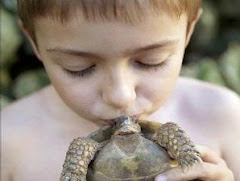





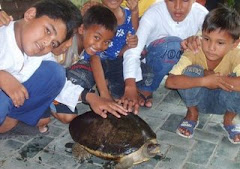













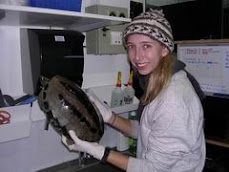



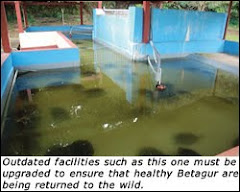.jpg)



